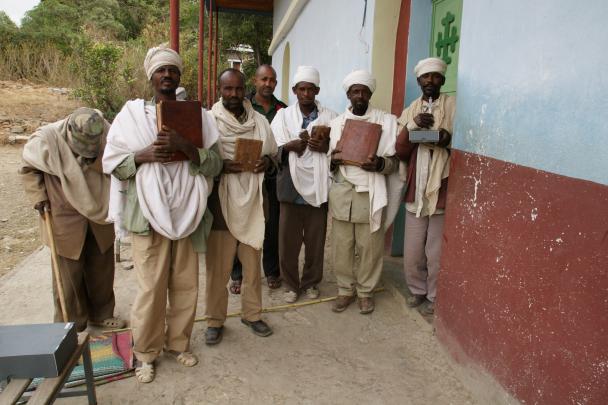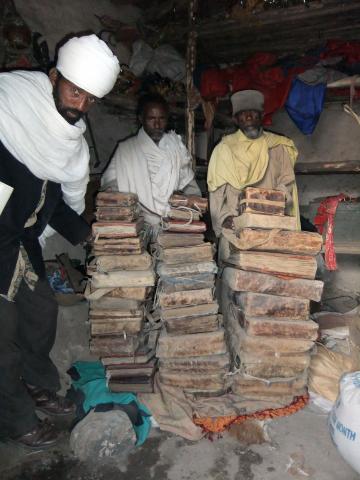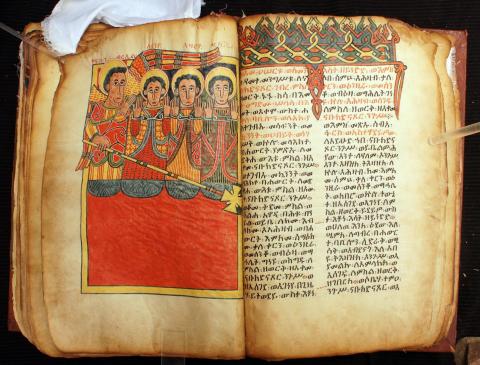
Aims and objectives
This project aims to digitise the library in the church Romanat Qeddus Mikael Dabre Mehret, Enderta. The library possesses around 70 codices and includes several valuable manuscripts of high quality, some of them with illuminations and valuable marginalia. The collection builds an indigenous and integral local documentary archive in a region important for the history of Ethiopia. The library remains practically unknown and unregistered and is endangered due to the poor preservation conditions and relatively easy access.
The Christian Ethiopian Civilisation has long attracted scholars' attention - particularly the highlands, where Christianity was introduced in the 4th century, in the present-day northern part of Tigray province. The numerous churches and monasteries of the area and their manuscript collections bear witness to the ancient history. Each year however, the old manuscript heritage of Ethiopian monasteries diminishes - victim of thefts, fires, poor preservation conditions and lack of consciousness of the religious communities.
The library of Romanat Qeddus Mikael was built up over more than 300 years. Among the books preserved in the monastery, the following are of specific significance: a large Synaxarion, commissioned by Sellus Hayla, most probably the wife of King Minas (r. 1559-63); a monumental manuscript of Gebre Hemamat (the Rite of the Holy Week), from the late 17th - first half of the 18th cent., a beautiful example of the Gondarine scribal art; the Vita of Anania, a holy monk (until now, it has been known only from the paper copy, made in the beginning of the 20th century for an Italian scholar).
Most of the manuscripts are more or less well preserved, including the most valuable pieces, but there are a few older manuscripts which today are in poor condition. The church was completely rebuilt some 15 years ago but the books are preserved in the traditional way. The collection is particularly endangered since it is practically unknown and unregistered. There is no exact register of the books and most of the books are not used for the church service anymore.
The original manuscripts will remain in the church. The digital copies will go to the British Library; the Romanat church; Tigray Culture and Tourism Agency Office, Mekelle; the Research Unit Ethiopian Studies, Hamburg University; and the Institute of Ethiopian Studies, Addis Ababa.
Outcomes
The ecclesiastic library of Romanat Qeddus Mika’el has now been completely digitised (89 electronic folders with 7,296 Tiff images) and secured. The full and detailed register of the collection has been produced. The preservation conditions for the most valuable part of the collection have been improved with the most important or damaged manuscripts placed in archival preservation boxes, and a new cupboard installed in the treasury for storage of the most valuable books (previously they were hanging on the walls or were deposited on the ground). The awareness of the community concerning preservation of their historical heritage has been raised.
Both the contents and physical features of the manuscripts have been recorded in details. The images are now available for the future research, in both the country of the origin of the collection, and outside. The local institution authorised for dealing with the preservation of the local historical heritage, Tigray Tourism and Culture Agency, now possesses full information about the collection, which effectively prevents any theft attempts.
Digital copies of the material have been deposited in the following institutions:
- The British Library, London, UK;
- Tigray Tourism and Culture Agency, Mekelle, Ethiopia;
- The Secretariat of the Tigray South Eastern Zone Diocese, Mekelle, Ethiopia;
- Hiob Ludolf Center for Ethiopian Studies, Hamburg University, Germany.
Members of the Tigray Tourism and Culture Agency have participated in the digitisation of the material and gained experience in all technological stages of the process, especially in dealing with the SONY A700 camera. The members of the community were instructed in the basics of manuscript heritage preservation.
The records copied by this project have been catalogued as:
- EAP254/1 Romanat Qeddus Michael Manuscript Collection [Second half of the 16th-20th century]
Due to the cyber-attack on the British Library in October 2023, the archives and manuscripts database is currently inaccessible and we are unable to provide links to the catalogue records for this project.



